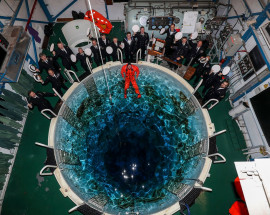 Last SETT team at tank
Last SETT team at tank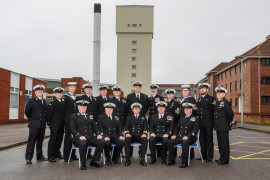 Last SETT training team
Last SETT training team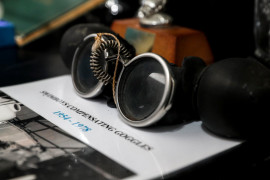 SETT goggle
SETT goggle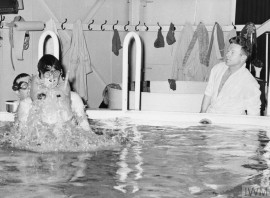 Prince of Wales in SETT escape tank
Prince of Wales in SETT escape tank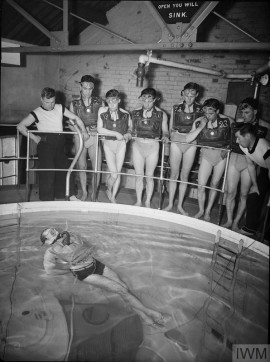 WW2 escape tank Gosport
WW2 escape tank Gosport
The plug has been pulled on the iconic water tank in Gosport where generations of Royal Navy submariners were trained to save their own lives in the event of a sinking.
For the final time the team who taught sailors how to escape from a stricken boat gathered at the Submarine Escape Training Tank (SETT) before the towering structure officially closes.
Tens of thousands of submariners have ascended the 100ft column of warm water since 13th July 1954, when the first man entered the airlock at the bottom of the tank to simulate emerging from a sunken submarine.
With the Royal Navy’s entire submarine flotilla moving to Faslane, as well as advances in submarine design, escape training and changes in the way rescues are handled, the SETT is no longer required.
The familiar tower block was built between 1949 and 1953 as part of a revamp of submarine escape training, prompted by a report drawn up by Captain Phillip Ruck-Keene just after World War 2.
The loss of HMS Thetis just before the war, and of HMS Truculent, which sank in the Thames after colliding with a tanker in January 1950 – both with heavy loss of life - as well as many other submarine accidents and experiences played a significant role in the training overhaul.
Using the circular tank, submariners were expected to 'escape' without complete breathing apparatus – instead they used the so-called Davis apparatus, a relatively simple device that allowed them to breathe as required during the ascent, and which acted as a buoyancy device as well.
During the 1960s and 1970s, around 4,500 submariners every year made the short but daunting journey to the top of the tank – it is thought it has been used more than 150,000 times in its 66-year life.
In recent times the tank had become just one element of the UK’s submarine rescue capability, which also includes the Submarine Parachute Assistance Group (SPAG – the folk who jump from aircraft straight into the sea to help crew who’ve escaped from a boat as taught in the SETT), and NATO’s Submarine Rescue System ‘Nemo’, also based in Faslane.
The Royal Navy stopped pressurised ascent training in the 900,000-litre tank in 2012, but was still using the facility for non-pressurised drills and teaching.
During the time the SETT was in use only one British submarine – HMS Artemis – has been lost.
Ironically, she sank at her moorings at HMS Dolphin in the summer of 1971 while being refuelled, almost within the shadow of the tower; fortunately there were no casualties in the accident, which saw the boat sink in 30ft of water.
The SETT will be replaced this year by the SubMarine Escape Rescue Abandonment and Survival Training Facility (SMERAS TF). The team will be moving en-masse from Gosport to Faslane, leaving a skeleton team behind on the South Coast.
“2020 marks the end of an era, so it’s a poignant moment for all of us,” said Lt Cdr Gareth ‘Griff’ Griffiths, who is in charge of the team.
“We’re looking forward to carrying the lessons of our past many years into the future of submarine escape, rescue, abandonment and survival training.
“Our success is due, in no small part, to our commitment to one another and the unique perspective of being submariners.”
At the heart of the replacement complex at Faslane is a huge ‘abandonment and sea survival training environmental pool’, where various weather conditions and sea states can be replicated in the safety of an indoor pool.
The SETT will remain a feature of the harbour skyline – as a listed building it is protected by law for its national and international role in submarine safety, and must be preserved.
Our images from the Royal Navy (© UK Ministry of Defence CROWN COPYRIGHT, 2019) show the training team at the top of the SETT, the SETT team in front of the iconic tower and a set of goggles used in the SETT which are now in the unit’s archives.
The Imperial War Museum also have archive images of submarine escape training, including Prince Charles in the tank in January 1972, when he ascended from 30ft and 60ft – (© IWM (A 35379)), and an instructor using the Davis apparatus in an earlier version of the SETT at HMS Dolphin in December 1942 (© IWM (A 13884))